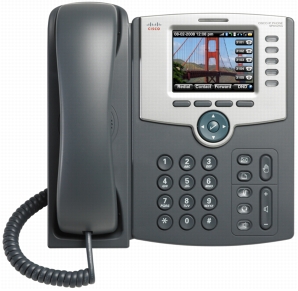Feature | Benefit |
Lighted line keys | 5 illuminated call appearance line buttons with tricolor LEDs |
Hold key | Puts current call on hold |
Voicemail key | One button access to voicemail |
Menu key | Accesses Call History, Directory, Speed Dials, MP3 Player, Web Applications, User Preferences, Network Configuration, Device Administration and Status |
Lighted mute key | Lights up red when the call is on mute, and turns off when mute is removed |
Lighted headset key | Lights up when pressed and using a Bluetooth or 2.5-mm headset for hands-free calling |
Lighted speakerphone key | Activates full-duplex speakerphone; stays lit while speakerphone is on |
Lighted message waiting indicator | Lights when there is new voicemail; visible on the phone chassis above the LCD screen; stays lit until the new voicemail has been processed by the user |
Graphical display | Color 3.2-in. QVGA (320 x 240) LCD graphical display |
5-way navigational buttons | Navigating menus and multimedia applications |
4 soft-key buttons | Dynamically present calling options to the user |
Network features | Cisco Discovery Protocol, IEEE 802.1p/Q |
Wi-Fi | 802.11b/g, Wi-Fi Multimedia (WMM) (802.11e) |
Wi-Fi security | • Wired Equivalent Privacy (WEP), 64 or 128 bit • Wi-Fi Protected Access (WPA), Personal and Enterprise • WPA2, Personal and Enterprise • Wi-Fi Protected Setup (WPS) |
Ethernet switch | 10/100 PC switch port enables LAN connectivity to a co-located PC. The system administrator can designate separate VLANs (802.1Q) for the PC and Cisco IP phones, providing improved security and reliability of voice and data traffic. 802.3af PoE WAN port. |
Volume control | Volume-control toggle provides easy decibel-level adjustments of the handset, monitor speaker, and ringer. |
Applications | • Customizable screen saver on phone display (Photo Album) • Music player (MP3) • RSS web services • Cisco Monitor View • SIP third-party call control for server-based applications • Lightweight Directory Access Protocol (LDAP) and Cisco XML-based corporate directory support |
Call control and audio features | • Call hold • Music on hold** • Call waiting • Caller ID name and number and outbound caller ID blocking • Caller ID mapping for incoming calls • Outbound caller ID blocking • Call transfer-attended or blind • Call conferencing-hosted (N-party) or local (3-party) • Call forwarding-unconditional, no answer, on busy • Visual voice message waiting indicator (VMWI) • Shared/bridge line appearance** • Call pickup-selective and group** • Call park and unpark** • Call back on busy • Call blocking-anonymous and selective • Do not disturb • Intercom** • Group paging** • Extension mobility** • Configurable dial/numbering plan support with interdigit timers-per line • URL (IP) dialing support • Distinctive ringing based on calling and called number • Supplementary services feature activation codes • Supplementary services announcements codes • Configurable supplementary services soft keys • Individual volume setting per each audio path (headset/handset/speaker) **Feature requires support by SIP/SPCP client management server. |
Signaling protocol support | • Smart Phone Control Protocol (SPCP) • SIP version 2 |
Voice features | • SIP proxy redundancy-dynamic via DNS SRV, A records • Reregistration with primary SIP proxy server • SIP support in network address translation (NAT) networks (including simple traversal [STUN]) • Codec name assignment • Voice algorithms: • G.711 (A-law and µ-law) • G.726 (32 kbps) • G.729 AB • G.722, Wideband Audio • Dynamic payload support • Adjustable audio frames per packet • Dual-tone multifrequency (DTMF): in-band and out-of-band (RFC 2833) (SIP INFO) • Flexible dial plan support with interdigit timers • IP address/Uniform Resource Identifier (URI) dialing support • Call progress tone generation • Jitter buffer-adaptive • Frame loss concealment • Voice activity detection (VAD) with silence suppression • Attenuation/gain adjustments • VMWI via NOTIFY, SUBSCRIBE • Caller ID support (name and number) |
Data features | • MAC address (IEEE 802.3) • IPv4 (RFC 791) • Address Resolution Protocol (ARP) • DNS A record (RFC 1706), SRV record (RFC 2782) • Dynamic Host Configuration Protocol (DHCP) client (RFC 2131) • Point-to-Point Protocol over Ethernet (PPoE) client (RFC 2516) • Internet Control Message Protocol (ICMP) (RFC 792) • TCP (RFC 793) • User Datagram Protocol (UDP) (RFC 768) • Real Time Protocol (RTP) (RFC 1889, 1890) • Real Time Control Protocol (RTCP) (RFC 1889) • Differentiated Services (DiffServ) (RFC 2475), type of service (ToS) (RFC 791, 1349) • VLAN tagging 802.1p/Q • Simple Network Time Protocol (SNTP) (RFC 2030) |
Security | • Password-protected system reset to factory default • Password-protected administrator and user access authority • HTTPS with factory-installed client certificate • HTTP digest-encrypted authentication via MD5 (RFC 1321) • Up to 256-bit Advanced Encryption Standard (AES) encryption • SIP over TLS for signaling encryption • SSL VPN • Secure RTP for media encryption |
Provisioning, administration, and maintenance | • Web browser administration and configuration via integrated web server • Automated provisioning and upgrade via HTTPS, HTTP, or (TFTP) • Asynchronous notification of upgrade availability via NOTIFY • Nonintrusive, in-service upgrades • Report generation and event logging • Stats in BYE message • RTP media loopback for quality of service (QoS) monitoring • Syslog and debug server records-per-line configurable |
